Comprehensive Business Model Analysis of TransferWise Company
VerifiedAdded on 2021/04/21
|13
|2598
|54
Report
AI Summary
This report provides a comprehensive analysis of TransferWise's business model, a peer-to-peer money transfer service. It utilizes the Business Model Canvas to dissect key components like key partners (e.g., investors, Starling Bank), key activities (e.g., customer acquisition, platform maintenance), key resources (e.g., financial capital, technology), value proposition (cheaper, no currency conversion), customer relationships (affiliate program), customer segments (migrant workers, freelancers), channels, cost structure, and revenue streams. The report also examines the interrelationships between these building blocks, identifies critical success factors (strategic focus, people, operations, marketing, finance), and assesses downside risks. Furthermore, it recommends changes such as increased technological investment and improved customer communication. The analysis concludes with an overview of TransferWise's operations within the competitive financial services industry.

Name of student:
Registration number:
Unit Title:
Unit Code:
Name of Supervisor:
Date
Registration number:
Unit Title:
Unit Code:
Name of Supervisor:
Date
Paraphrase This Document
Need a fresh take? Get an instant paraphrase of this document with our AI Paraphraser

Contents
Introduction.................................................................................................................................................2
Business Model Canvas...............................................................................................................................2
Key relationship between the nine building blocks.....................................................................................4
Critical success factors.................................................................................................................................5
Downside Risk.............................................................................................................................................6
Recommended changes..............................................................................................................................6
Conclusion...................................................................................................................................................7
Introduction.................................................................................................................................................2
Business Model Canvas...............................................................................................................................2
Key relationship between the nine building blocks.....................................................................................4
Critical success factors.................................................................................................................................5
Downside Risk.............................................................................................................................................6
Recommended changes..............................................................................................................................6
Conclusion...................................................................................................................................................7

Introduction
Transfer Wise is an Estonian Company that is currently based in the UK. The company offers
peer to peer money transfer services within the countries it operates. The company was launched
in the year 2011. Its operations are global but the business mainly depends on Europe, US and
Latin America. As at the year 2018, Transfer Wise had approximately 1000 employees. The
products offered by the company include transferring different currencies globally without
having to convert the currency. TransferWise operates in the financial services industry. The
financial services industry is very huge in size and its segmented into various markets such as
insurance,consumer finance,investment banking and money transfer(Türko, 2016).TransferWise
operates in the money transfer market. The money transfer market has grown tremendously in
the last one decade. Money transfer industry has evolved from being a preserve of the banks and
it has become digital and more efficient.
Business Model Canvas
Key partners
The business model canvas of TransferWise is made based on Osterwalder and Pegneur nine
pillars. TransferWisehassome partners who are instrumental in the success of the company. The
company has partnered with several investors to help invest in technology and grow the company
further. Some of these firms include; IA Ventures,IndexVentures,IJNR ventures and Velar
Ventures. To offer efficient services,the company has also partnered with other service providers
such as commercial banks. One of these institutions is Starling Bank. Starling bank offers digital
banking services only and its partnership with TransferWise will make international money
transfer easier and cheaper(Keane, Cormican&Sheahan, 2018).
Key activities
Transfer Wise is an Estonian Company that is currently based in the UK. The company offers
peer to peer money transfer services within the countries it operates. The company was launched
in the year 2011. Its operations are global but the business mainly depends on Europe, US and
Latin America. As at the year 2018, Transfer Wise had approximately 1000 employees. The
products offered by the company include transferring different currencies globally without
having to convert the currency. TransferWise operates in the financial services industry. The
financial services industry is very huge in size and its segmented into various markets such as
insurance,consumer finance,investment banking and money transfer(Türko, 2016).TransferWise
operates in the money transfer market. The money transfer market has grown tremendously in
the last one decade. Money transfer industry has evolved from being a preserve of the banks and
it has become digital and more efficient.
Business Model Canvas
Key partners
The business model canvas of TransferWise is made based on Osterwalder and Pegneur nine
pillars. TransferWisehassome partners who are instrumental in the success of the company. The
company has partnered with several investors to help invest in technology and grow the company
further. Some of these firms include; IA Ventures,IndexVentures,IJNR ventures and Velar
Ventures. To offer efficient services,the company has also partnered with other service providers
such as commercial banks. One of these institutions is Starling Bank. Starling bank offers digital
banking services only and its partnership with TransferWise will make international money
transfer easier and cheaper(Keane, Cormican&Sheahan, 2018).
Key activities
⊘ This is a preview!⊘
Do you want full access?
Subscribe today to unlock all pages.

Trusted by 1+ million students worldwide
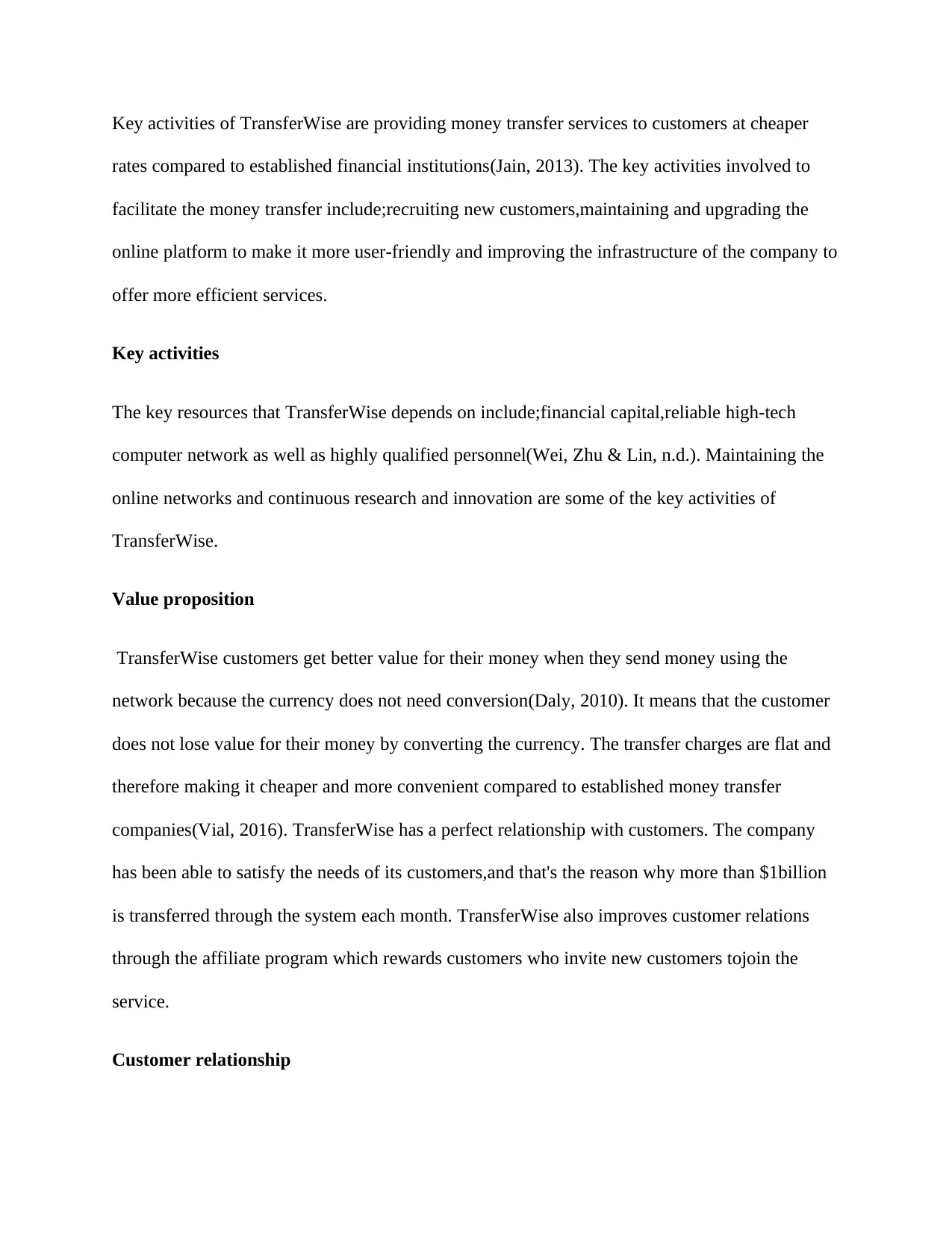
Key activities of TransferWise are providing money transfer services to customers at cheaper
rates compared to established financial institutions(Jain, 2013). The key activities involved to
facilitate the money transfer include;recruiting new customers,maintaining and upgrading the
online platform to make it more user-friendly and improving the infrastructure of the company to
offer more efficient services.
Key activities
The key resources that TransferWise depends on include;financial capital,reliable high-tech
computer network as well as highly qualified personnel(Wei, Zhu & Lin, n.d.). Maintaining the
online networks and continuous research and innovation are some of the key activities of
TransferWise.
Value proposition
TransferWise customers get better value for their money when they send money using the
network because the currency does not need conversion(Daly, 2010). It means that the customer
does not lose value for their money by converting the currency. The transfer charges are flat and
therefore making it cheaper and more convenient compared to established money transfer
companies(Vial, 2016). TransferWise has a perfect relationship with customers. The company
has been able to satisfy the needs of its customers,and that's the reason why more than $1billion
is transferred through the system each month. TransferWise also improves customer relations
through the affiliate program which rewards customers who invite new customers tojoin the
service.
Customer relationship
rates compared to established financial institutions(Jain, 2013). The key activities involved to
facilitate the money transfer include;recruiting new customers,maintaining and upgrading the
online platform to make it more user-friendly and improving the infrastructure of the company to
offer more efficient services.
Key activities
The key resources that TransferWise depends on include;financial capital,reliable high-tech
computer network as well as highly qualified personnel(Wei, Zhu & Lin, n.d.). Maintaining the
online networks and continuous research and innovation are some of the key activities of
TransferWise.
Value proposition
TransferWise customers get better value for their money when they send money using the
network because the currency does not need conversion(Daly, 2010). It means that the customer
does not lose value for their money by converting the currency. The transfer charges are flat and
therefore making it cheaper and more convenient compared to established money transfer
companies(Vial, 2016). TransferWise has a perfect relationship with customers. The company
has been able to satisfy the needs of its customers,and that's the reason why more than $1billion
is transferred through the system each month. TransferWise also improves customer relations
through the affiliate program which rewards customers who invite new customers tojoin the
service.
Customer relationship
Paraphrase This Document
Need a fresh take? Get an instant paraphrase of this document with our AI Paraphraser
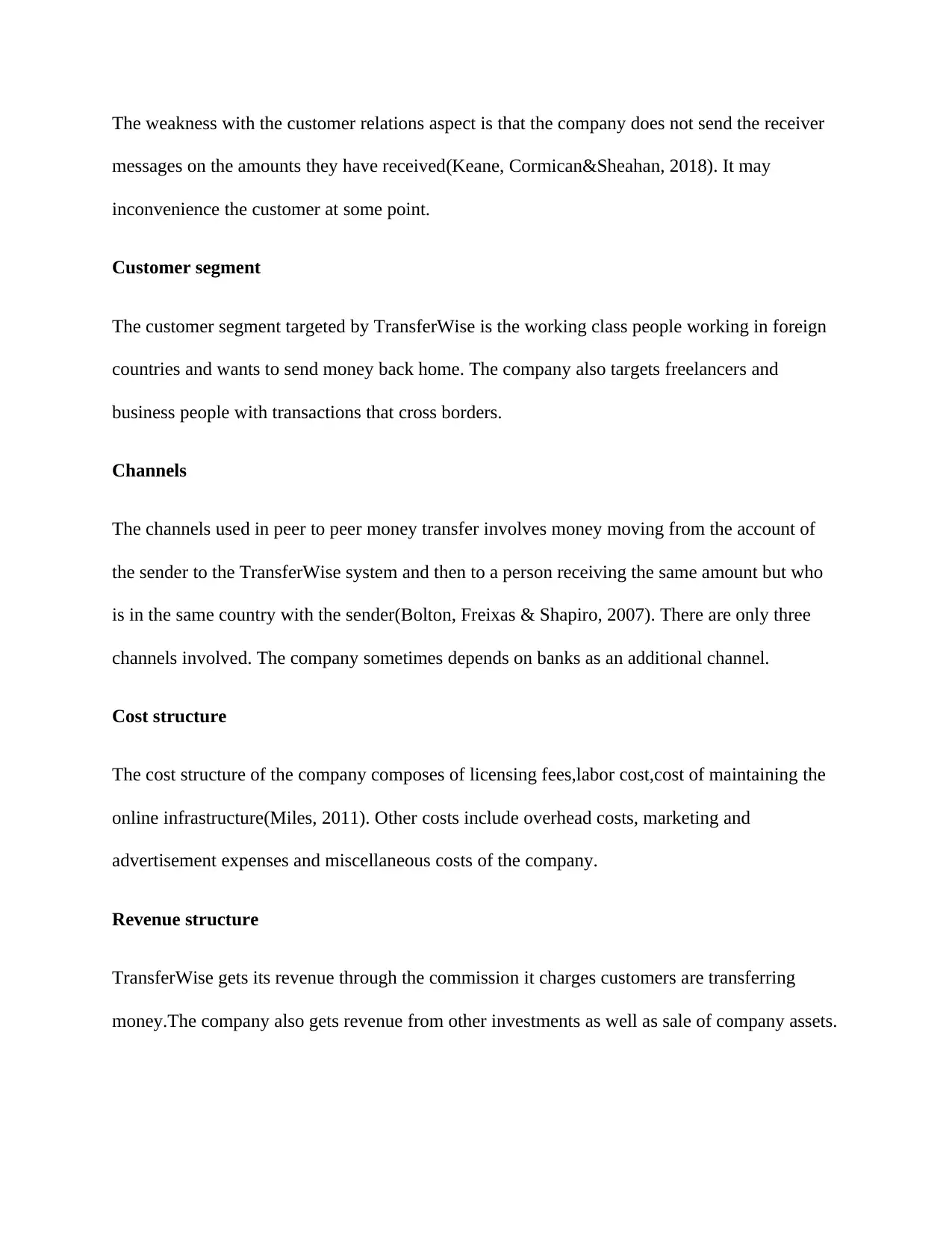
The weakness with the customer relations aspect is that the company does not send the receiver
messages on the amounts they have received(Keane, Cormican&Sheahan, 2018). It may
inconvenience the customer at some point.
Customer segment
The customer segment targeted by TransferWise is the working class people working in foreign
countries and wants to send money back home. The company also targets freelancers and
business people with transactions that cross borders.
Channels
The channels used in peer to peer money transfer involves money moving from the account of
the sender to the TransferWise system and then to a person receiving the same amount but who
is in the same country with the sender(Bolton, Freixas & Shapiro, 2007). There are only three
channels involved. The company sometimes depends on banks as an additional channel.
Cost structure
The cost structure of the company composes of licensing fees,labor cost,cost of maintaining the
online infrastructure(Miles, 2011). Other costs include overhead costs, marketing and
advertisement expenses and miscellaneous costs of the company.
Revenue structure
TransferWise gets its revenue through the commission it charges customers are transferring
money.The company also gets revenue from other investments as well as sale of company assets.
messages on the amounts they have received(Keane, Cormican&Sheahan, 2018). It may
inconvenience the customer at some point.
Customer segment
The customer segment targeted by TransferWise is the working class people working in foreign
countries and wants to send money back home. The company also targets freelancers and
business people with transactions that cross borders.
Channels
The channels used in peer to peer money transfer involves money moving from the account of
the sender to the TransferWise system and then to a person receiving the same amount but who
is in the same country with the sender(Bolton, Freixas & Shapiro, 2007). There are only three
channels involved. The company sometimes depends on banks as an additional channel.
Cost structure
The cost structure of the company composes of licensing fees,labor cost,cost of maintaining the
online infrastructure(Miles, 2011). Other costs include overhead costs, marketing and
advertisement expenses and miscellaneous costs of the company.
Revenue structure
TransferWise gets its revenue through the commission it charges customers are transferring
money.The company also gets revenue from other investments as well as sale of company assets.
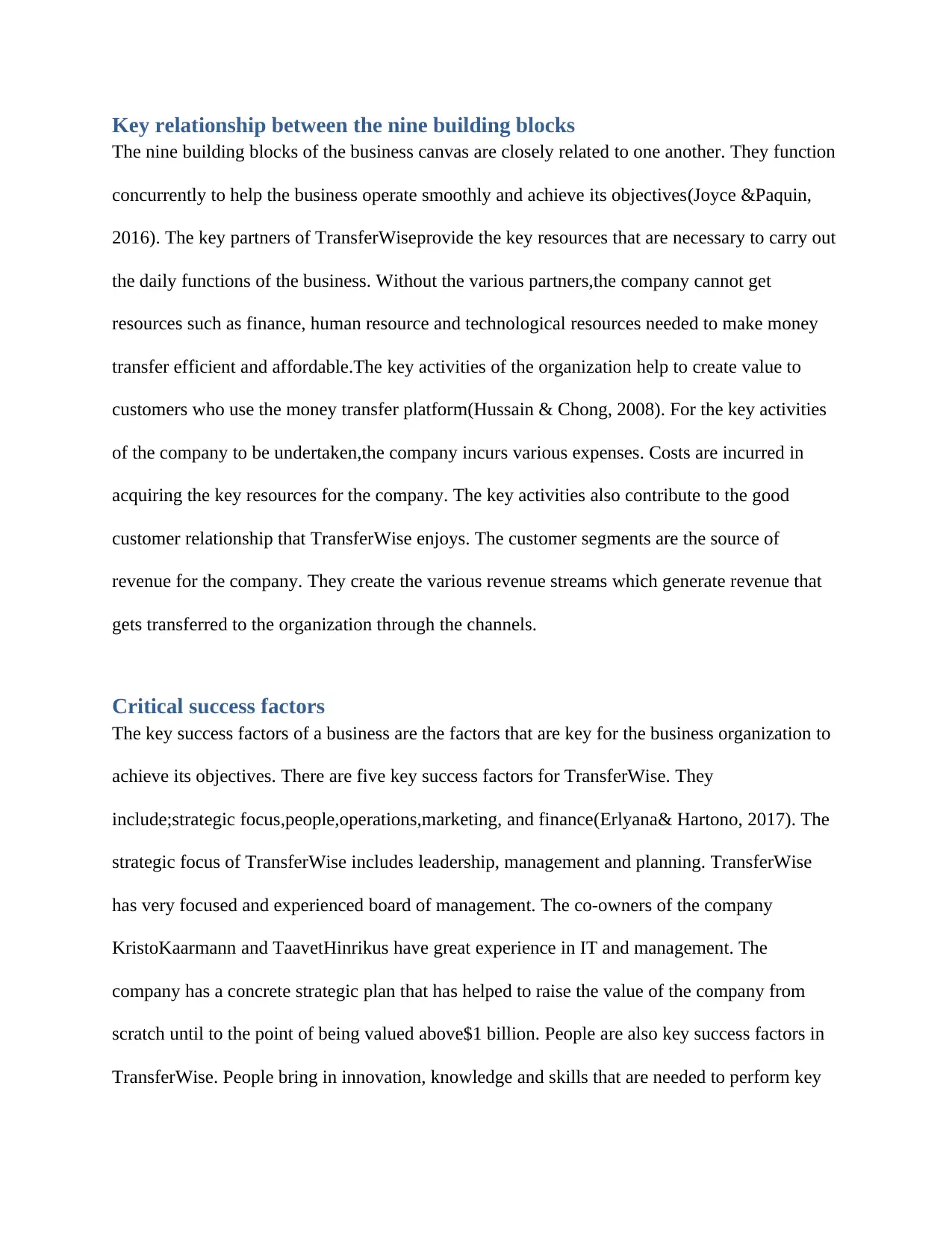
Key relationship between the nine building blocks
The nine building blocks of the business canvas are closely related to one another. They function
concurrently to help the business operate smoothly and achieve its objectives(Joyce &Paquin,
2016). The key partners of TransferWiseprovide the key resources that are necessary to carry out
the daily functions of the business. Without the various partners,the company cannot get
resources such as finance, human resource and technological resources needed to make money
transfer efficient and affordable.The key activities of the organization help to create value to
customers who use the money transfer platform(Hussain & Chong, 2008). For the key activities
of the company to be undertaken,the company incurs various expenses. Costs are incurred in
acquiring the key resources for the company. The key activities also contribute to the good
customer relationship that TransferWise enjoys. The customer segments are the source of
revenue for the company. They create the various revenue streams which generate revenue that
gets transferred to the organization through the channels.
Critical success factors
The key success factors of a business are the factors that are key for the business organization to
achieve its objectives. There are five key success factors for TransferWise. They
include;strategic focus,people,operations,marketing, and finance(Erlyana& Hartono, 2017). The
strategic focus of TransferWise includes leadership, management and planning. TransferWise
has very focused and experienced board of management. The co-owners of the company
KristoKaarmann and TaavetHinrikus have great experience in IT and management. The
company has a concrete strategic plan that has helped to raise the value of the company from
scratch until to the point of being valued above$1 billion. People are also key success factors in
TransferWise. People bring in innovation, knowledge and skills that are needed to perform key
The nine building blocks of the business canvas are closely related to one another. They function
concurrently to help the business operate smoothly and achieve its objectives(Joyce &Paquin,
2016). The key partners of TransferWiseprovide the key resources that are necessary to carry out
the daily functions of the business. Without the various partners,the company cannot get
resources such as finance, human resource and technological resources needed to make money
transfer efficient and affordable.The key activities of the organization help to create value to
customers who use the money transfer platform(Hussain & Chong, 2008). For the key activities
of the company to be undertaken,the company incurs various expenses. Costs are incurred in
acquiring the key resources for the company. The key activities also contribute to the good
customer relationship that TransferWise enjoys. The customer segments are the source of
revenue for the company. They create the various revenue streams which generate revenue that
gets transferred to the organization through the channels.
Critical success factors
The key success factors of a business are the factors that are key for the business organization to
achieve its objectives. There are five key success factors for TransferWise. They
include;strategic focus,people,operations,marketing, and finance(Erlyana& Hartono, 2017). The
strategic focus of TransferWise includes leadership, management and planning. TransferWise
has very focused and experienced board of management. The co-owners of the company
KristoKaarmann and TaavetHinrikus have great experience in IT and management. The
company has a concrete strategic plan that has helped to raise the value of the company from
scratch until to the point of being valued above$1 billion. People are also key success factors in
TransferWise. People bring in innovation, knowledge and skills that are needed to perform key
⊘ This is a preview!⊘
Do you want full access?
Subscribe today to unlock all pages.

Trusted by 1+ million students worldwide
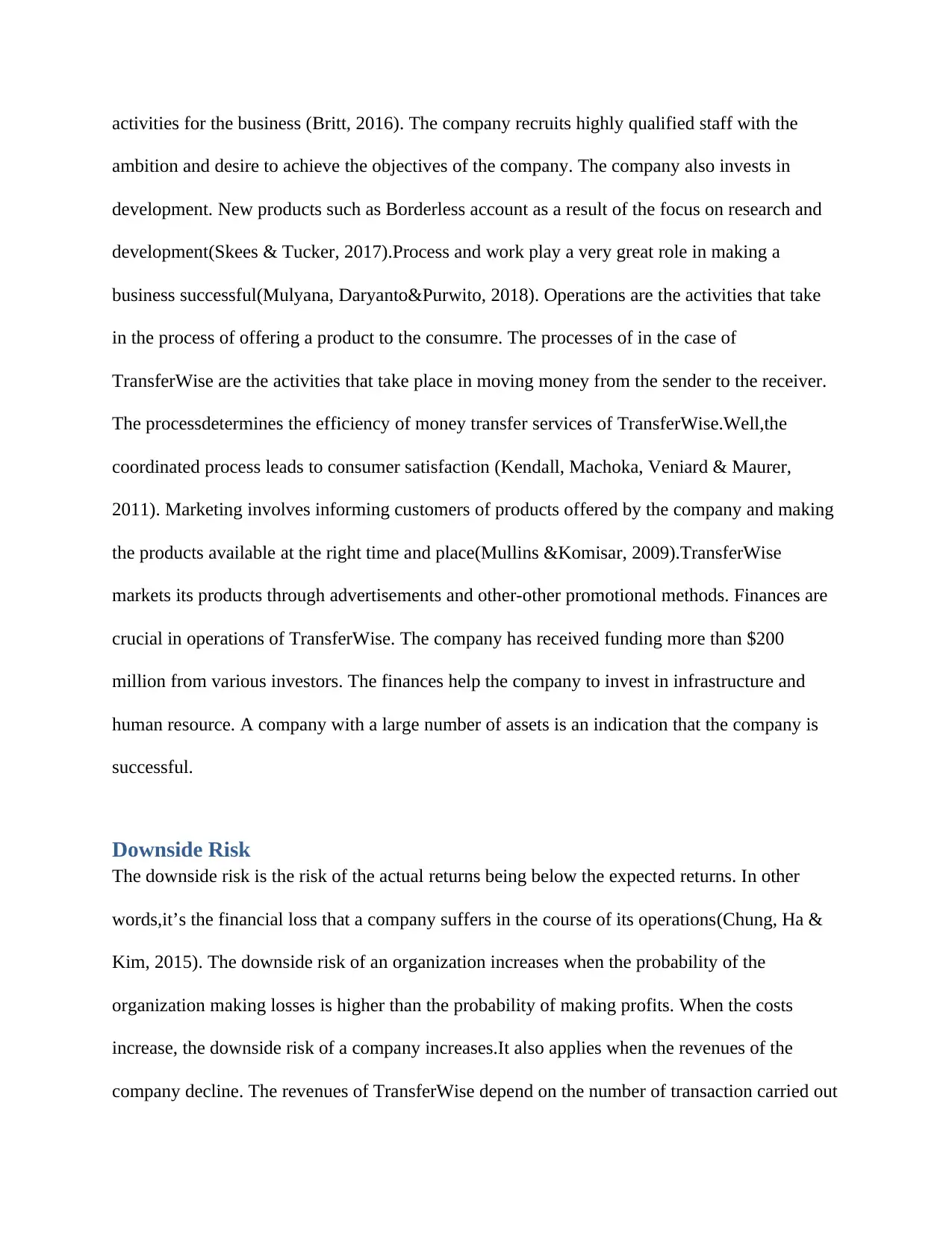
activities for the business (Britt, 2016). The company recruits highly qualified staff with the
ambition and desire to achieve the objectives of the company. The company also invests in
development. New products such as Borderless account as a result of the focus on research and
development(Skees & Tucker, 2017).Process and work play a very great role in making a
business successful(Mulyana, Daryanto&Purwito, 2018). Operations are the activities that take
in the process of offering a product to the consumre. The processes of in the case of
TransferWise are the activities that take place in moving money from the sender to the receiver.
The processdetermines the efficiency of money transfer services of TransferWise.Well,the
coordinated process leads to consumer satisfaction (Kendall, Machoka, Veniard & Maurer,
2011). Marketing involves informing customers of products offered by the company and making
the products available at the right time and place(Mullins &Komisar, 2009).TransferWise
markets its products through advertisements and other-other promotional methods. Finances are
crucial in operations of TransferWise. The company has received funding more than $200
million from various investors. The finances help the company to invest in infrastructure and
human resource. A company with a large number of assets is an indication that the company is
successful.
Downside Risk
The downside risk is the risk of the actual returns being below the expected returns. In other
words,it’s the financial loss that a company suffers in the course of its operations(Chung, Ha &
Kim, 2015). The downside risk of an organization increases when the probability of the
organization making losses is higher than the probability of making profits. When the costs
increase, the downside risk of a company increases.It also applies when the revenues of the
company decline. The revenues of TransferWise depend on the number of transaction carried out
ambition and desire to achieve the objectives of the company. The company also invests in
development. New products such as Borderless account as a result of the focus on research and
development(Skees & Tucker, 2017).Process and work play a very great role in making a
business successful(Mulyana, Daryanto&Purwito, 2018). Operations are the activities that take
in the process of offering a product to the consumre. The processes of in the case of
TransferWise are the activities that take place in moving money from the sender to the receiver.
The processdetermines the efficiency of money transfer services of TransferWise.Well,the
coordinated process leads to consumer satisfaction (Kendall, Machoka, Veniard & Maurer,
2011). Marketing involves informing customers of products offered by the company and making
the products available at the right time and place(Mullins &Komisar, 2009).TransferWise
markets its products through advertisements and other-other promotional methods. Finances are
crucial in operations of TransferWise. The company has received funding more than $200
million from various investors. The finances help the company to invest in infrastructure and
human resource. A company with a large number of assets is an indication that the company is
successful.
Downside Risk
The downside risk is the risk of the actual returns being below the expected returns. In other
words,it’s the financial loss that a company suffers in the course of its operations(Chung, Ha &
Kim, 2015). The downside risk of an organization increases when the probability of the
organization making losses is higher than the probability of making profits. When the costs
increase, the downside risk of a company increases.It also applies when the revenues of the
company decline. The revenues of TransferWise depend on the number of transaction carried out
Paraphrase This Document
Need a fresh take? Get an instant paraphrase of this document with our AI Paraphraser

through the platform,and hence they determine the risk of actual returns being below the
expected returns. The downside increases when the costs incurred by the company increase or
when the revenues decrease.
Recommended changes
The business model used by a business organization is very important in determining the success
of the business organization. One of the changes I would recommend to the business is the
increase in technological investment(Pollock & Price, 2008). The company should focus more on
technological innovation to be able to compete effectively in the ever-evolving financial industry
(Mohapatra, S& Ratha, 2011).I would also recommend that the company improves its
relationship with customers. TransferWise should improve communication with its customers to
improve customer satisfaction.TransferWise company should use target a wide range of
customer segment to gain more customers. The business model of TransferWise needs to be
changed by improving the value proposition to the customers (Ye, 2015). The company should
reduce the time it takes to transfer money from one account to the other. This can be done by
researching in technology in order to make the services more efficient. The revenue streams of
the company should be increased by the company offering mobile money transfer services.
Conclusion
This report analyzes the business model that TransferWise applies in its operations. The
company was formed in the year 2005 and it has over 1,000 employees. The company operates
in the financial industry which is very competitive and has evolved greatly over the past one
decade. The report discusses the nine building blocks of the business canvas model. The report
also discusses the relationship between the nine building blocks and how they affect the
expected returns. The downside increases when the costs incurred by the company increase or
when the revenues decrease.
Recommended changes
The business model used by a business organization is very important in determining the success
of the business organization. One of the changes I would recommend to the business is the
increase in technological investment(Pollock & Price, 2008). The company should focus more on
technological innovation to be able to compete effectively in the ever-evolving financial industry
(Mohapatra, S& Ratha, 2011).I would also recommend that the company improves its
relationship with customers. TransferWise should improve communication with its customers to
improve customer satisfaction.TransferWise company should use target a wide range of
customer segment to gain more customers. The business model of TransferWise needs to be
changed by improving the value proposition to the customers (Ye, 2015). The company should
reduce the time it takes to transfer money from one account to the other. This can be done by
researching in technology in order to make the services more efficient. The revenue streams of
the company should be increased by the company offering mobile money transfer services.
Conclusion
This report analyzes the business model that TransferWise applies in its operations. The
company was formed in the year 2005 and it has over 1,000 employees. The company operates
in the financial industry which is very competitive and has evolved greatly over the past one
decade. The report discusses the nine building blocks of the business canvas model. The report
also discusses the relationship between the nine building blocks and how they affect the
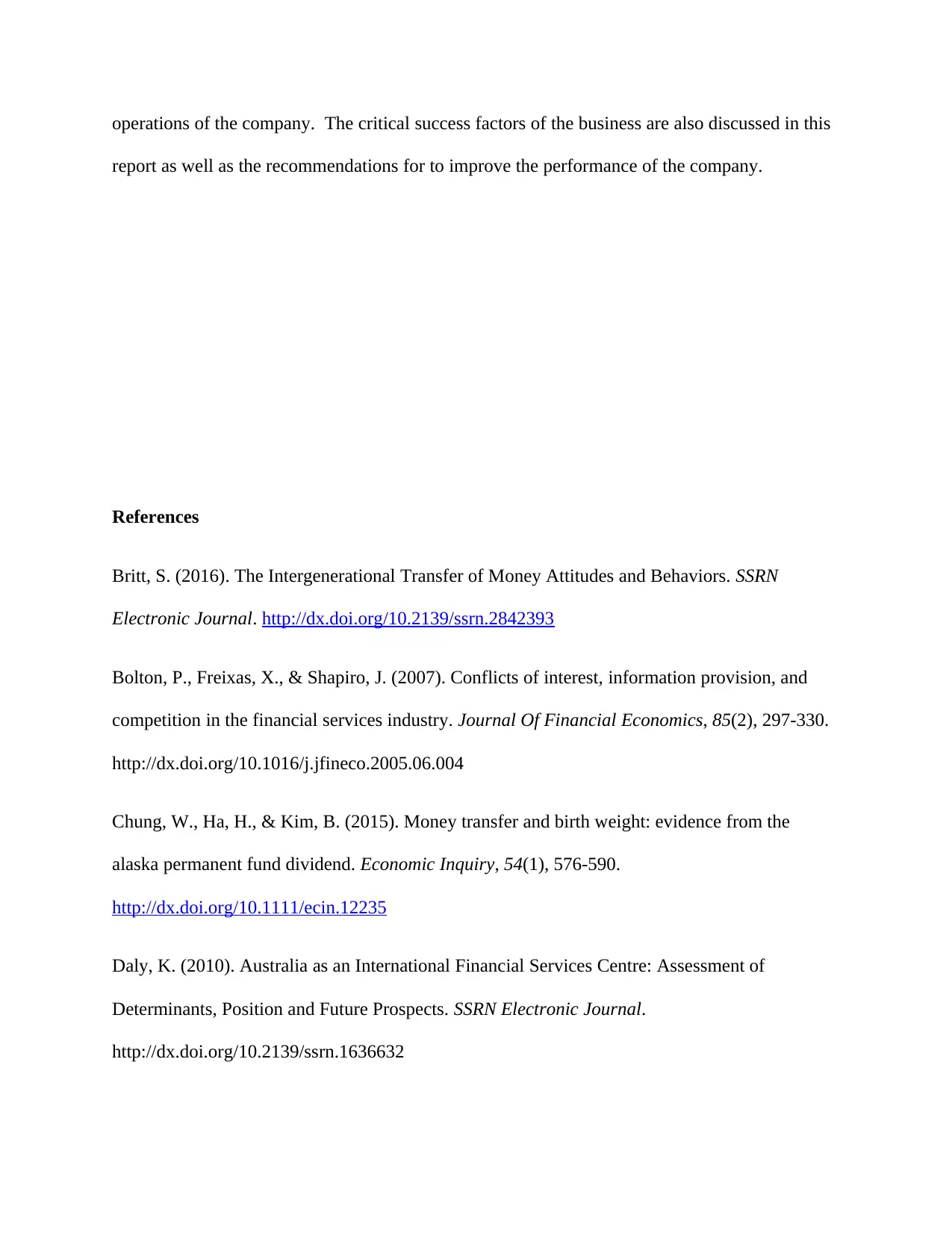
operations of the company. The critical success factors of the business are also discussed in this
report as well as the recommendations for to improve the performance of the company.
References
Britt, S. (2016). The Intergenerational Transfer of Money Attitudes and Behaviors. SSRN
Electronic Journal. http://dx.doi.org/10.2139/ssrn.2842393
Bolton, P., Freixas, X., & Shapiro, J. (2007). Conflicts of interest, information provision, and
competition in the financial services industry. Journal Of Financial Economics, 85(2), 297-330.
http://dx.doi.org/10.1016/j.jfineco.2005.06.004
Chung, W., Ha, H., & Kim, B. (2015). Money transfer and birth weight: evidence from the
alaska permanent fund dividend. Economic Inquiry, 54(1), 576-590.
http://dx.doi.org/10.1111/ecin.12235
Daly, K. (2010). Australia as an International Financial Services Centre: Assessment of
Determinants, Position and Future Prospects. SSRN Electronic Journal.
http://dx.doi.org/10.2139/ssrn.1636632
report as well as the recommendations for to improve the performance of the company.
References
Britt, S. (2016). The Intergenerational Transfer of Money Attitudes and Behaviors. SSRN
Electronic Journal. http://dx.doi.org/10.2139/ssrn.2842393
Bolton, P., Freixas, X., & Shapiro, J. (2007). Conflicts of interest, information provision, and
competition in the financial services industry. Journal Of Financial Economics, 85(2), 297-330.
http://dx.doi.org/10.1016/j.jfineco.2005.06.004
Chung, W., Ha, H., & Kim, B. (2015). Money transfer and birth weight: evidence from the
alaska permanent fund dividend. Economic Inquiry, 54(1), 576-590.
http://dx.doi.org/10.1111/ecin.12235
Daly, K. (2010). Australia as an International Financial Services Centre: Assessment of
Determinants, Position and Future Prospects. SSRN Electronic Journal.
http://dx.doi.org/10.2139/ssrn.1636632
⊘ This is a preview!⊘
Do you want full access?
Subscribe today to unlock all pages.

Trusted by 1+ million students worldwide

Erlyana, Y., & Hartono, H. (2017).The business model in marketplace industry using business
model canvas approach: An e-commerce case study. IOP Conference Series: Materials Science
And Engineering, 277, 012066. http://dx.doi.org/10.1088/1757-899x/277/1/012066
Joyce, A., &Paquin, R. (2016). The triple-layered business model canvas: A tool to design more
sustainable business models. Journal Of Cleaner Production, 135, 1474-1486.
http://dx.doi.org/10.1016/j.jclepro.2016.06.067
Hussain, M., & Chong, G. (2008). Non-Financial Performance Measurement Practices in
Financial Services Industry: An Agency Theory Approach. SSRN Electronic Journal.
http://dx.doi.org/10.2139/ssrn.1082906
Jain, A. (2013). Regulation of Financial Services in Australia. SSRN Electronic Journal.
http://dx.doi.org/10.2139/ssrn.2343068
Kendall, J., Machoka, P., Veniard, C., & Maurer, B. (2011). An Emerging Platform: From
Money Transfer System to Mobile Money Ecosystem. SSRN Electronic Journal.
http://dx.doi.org/10.2139/ssrn.1830704
Keane, S., Cormican, K., &Sheahan, J. (2018). Comparing how entrepreneurs and managers
represent the elements of the business model canvas. Journal Of Business Venturing Insights, 9,
65-74. http://dx.doi.org/10.1016/j.jbvi.2018.02.004
Miles, D. A. (2011).Risk factors and business models: Understanding the five forces of
entrepreneurial risk and the causes of business failure. Boca Raton: Dissertation.com.
Mullins, J., &Komisar, R. (2009).Getting to Plan B: Breaking Through to a Better Business
Model. Boston: Harvard Business Review Press.
model canvas approach: An e-commerce case study. IOP Conference Series: Materials Science
And Engineering, 277, 012066. http://dx.doi.org/10.1088/1757-899x/277/1/012066
Joyce, A., &Paquin, R. (2016). The triple-layered business model canvas: A tool to design more
sustainable business models. Journal Of Cleaner Production, 135, 1474-1486.
http://dx.doi.org/10.1016/j.jclepro.2016.06.067
Hussain, M., & Chong, G. (2008). Non-Financial Performance Measurement Practices in
Financial Services Industry: An Agency Theory Approach. SSRN Electronic Journal.
http://dx.doi.org/10.2139/ssrn.1082906
Jain, A. (2013). Regulation of Financial Services in Australia. SSRN Electronic Journal.
http://dx.doi.org/10.2139/ssrn.2343068
Kendall, J., Machoka, P., Veniard, C., & Maurer, B. (2011). An Emerging Platform: From
Money Transfer System to Mobile Money Ecosystem. SSRN Electronic Journal.
http://dx.doi.org/10.2139/ssrn.1830704
Keane, S., Cormican, K., &Sheahan, J. (2018). Comparing how entrepreneurs and managers
represent the elements of the business model canvas. Journal Of Business Venturing Insights, 9,
65-74. http://dx.doi.org/10.1016/j.jbvi.2018.02.004
Miles, D. A. (2011).Risk factors and business models: Understanding the five forces of
entrepreneurial risk and the causes of business failure. Boca Raton: Dissertation.com.
Mullins, J., &Komisar, R. (2009).Getting to Plan B: Breaking Through to a Better Business
Model. Boston: Harvard Business Review Press.
Paraphrase This Document
Need a fresh take? Get an instant paraphrase of this document with our AI Paraphraser
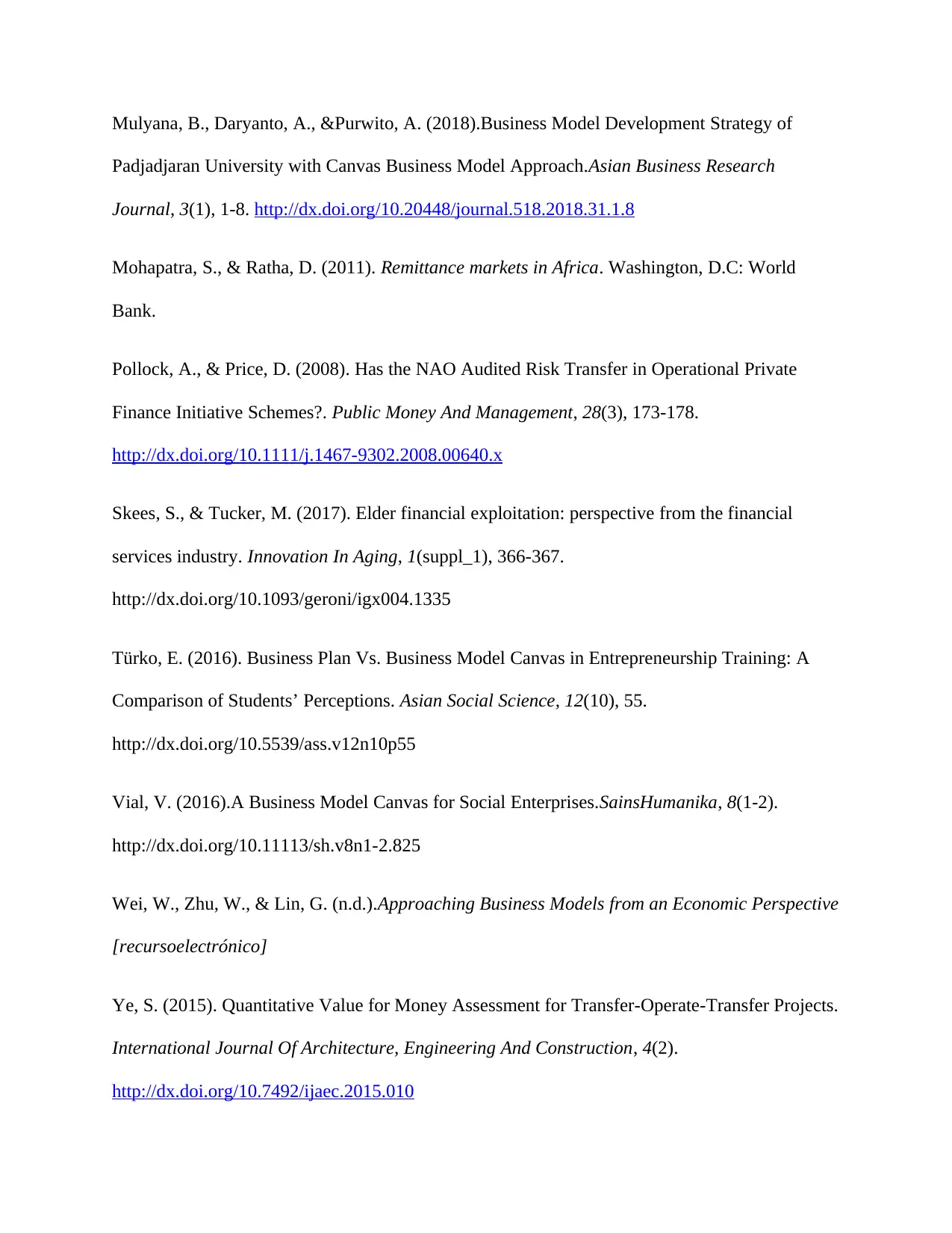
Mulyana, B., Daryanto, A., &Purwito, A. (2018).Business Model Development Strategy of
Padjadjaran University with Canvas Business Model Approach.Asian Business Research
Journal, 3(1), 1-8. http://dx.doi.org/10.20448/journal.518.2018.31.1.8
Mohapatra, S., & Ratha, D. (2011). Remittance markets in Africa. Washington, D.C: World
Bank.
Pollock, A., & Price, D. (2008). Has the NAO Audited Risk Transfer in Operational Private
Finance Initiative Schemes?. Public Money And Management, 28(3), 173-178.
http://dx.doi.org/10.1111/j.1467-9302.2008.00640.x
Skees, S., & Tucker, M. (2017). Elder financial exploitation: perspective from the financial
services industry. Innovation In Aging, 1(suppl_1), 366-367.
http://dx.doi.org/10.1093/geroni/igx004.1335
Türko, E. (2016). Business Plan Vs. Business Model Canvas in Entrepreneurship Training: A
Comparison of Students’ Perceptions. Asian Social Science, 12(10), 55.
http://dx.doi.org/10.5539/ass.v12n10p55
Vial, V. (2016).A Business Model Canvas for Social Enterprises.SainsHumanika, 8(1-2).
http://dx.doi.org/10.11113/sh.v8n1-2.825
Wei, W., Zhu, W., & Lin, G. (n.d.).Approaching Business Models from an Economic Perspective
[recursoelectrónico]
Ye, S. (2015). Quantitative Value for Money Assessment for Transfer-Operate-Transfer Projects.
International Journal Of Architecture, Engineering And Construction, 4(2).
http://dx.doi.org/10.7492/ijaec.2015.010
Padjadjaran University with Canvas Business Model Approach.Asian Business Research
Journal, 3(1), 1-8. http://dx.doi.org/10.20448/journal.518.2018.31.1.8
Mohapatra, S., & Ratha, D. (2011). Remittance markets in Africa. Washington, D.C: World
Bank.
Pollock, A., & Price, D. (2008). Has the NAO Audited Risk Transfer in Operational Private
Finance Initiative Schemes?. Public Money And Management, 28(3), 173-178.
http://dx.doi.org/10.1111/j.1467-9302.2008.00640.x
Skees, S., & Tucker, M. (2017). Elder financial exploitation: perspective from the financial
services industry. Innovation In Aging, 1(suppl_1), 366-367.
http://dx.doi.org/10.1093/geroni/igx004.1335
Türko, E. (2016). Business Plan Vs. Business Model Canvas in Entrepreneurship Training: A
Comparison of Students’ Perceptions. Asian Social Science, 12(10), 55.
http://dx.doi.org/10.5539/ass.v12n10p55
Vial, V. (2016).A Business Model Canvas for Social Enterprises.SainsHumanika, 8(1-2).
http://dx.doi.org/10.11113/sh.v8n1-2.825
Wei, W., Zhu, W., & Lin, G. (n.d.).Approaching Business Models from an Economic Perspective
[recursoelectrónico]
Ye, S. (2015). Quantitative Value for Money Assessment for Transfer-Operate-Transfer Projects.
International Journal Of Architecture, Engineering And Construction, 4(2).
http://dx.doi.org/10.7492/ijaec.2015.010
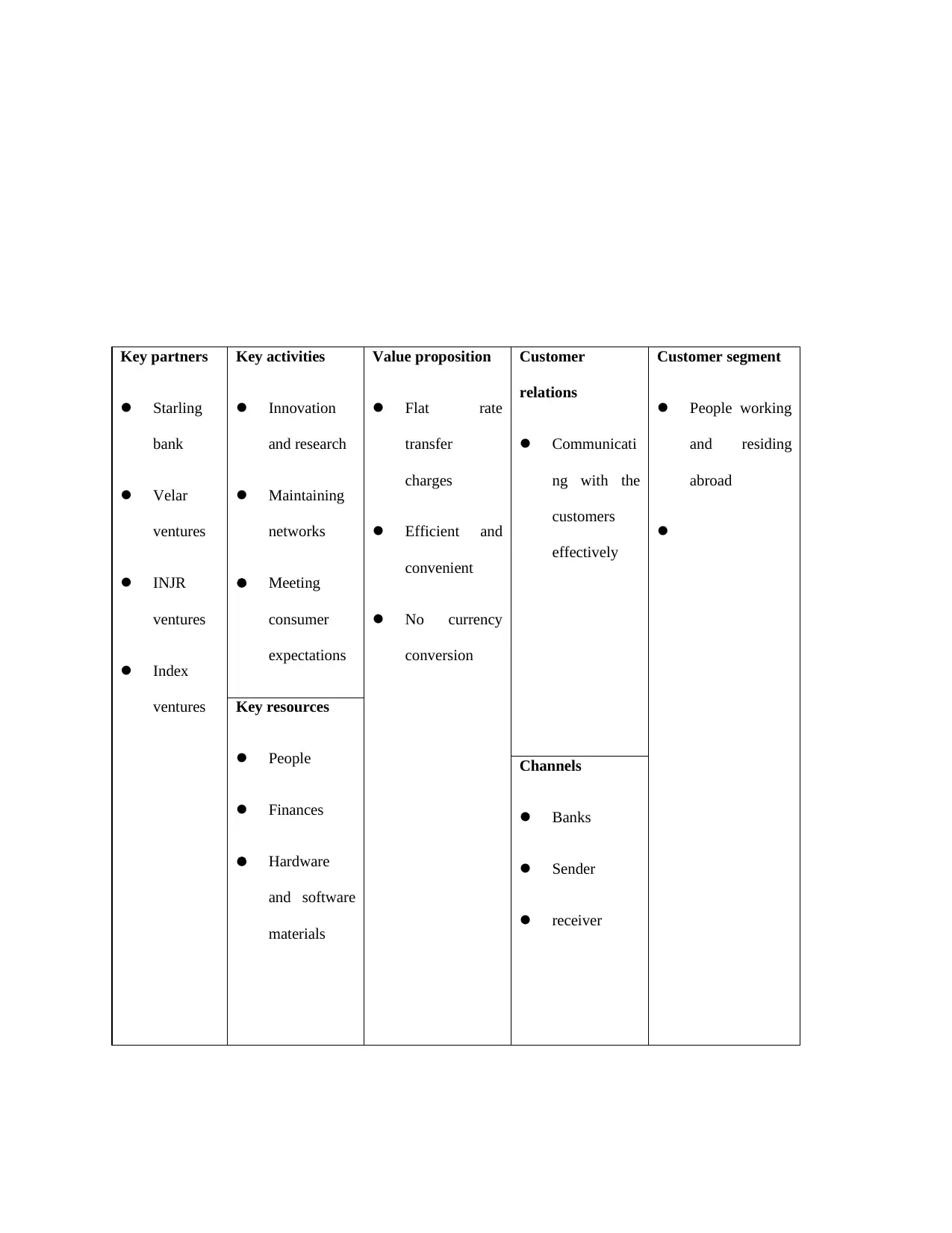
Key partners
Starling
bank
Velar
ventures
INJR
ventures
Index
ventures
Key activities
Innovation
and research
Maintaining
networks
Meeting
consumer
expectations
Value proposition
Flat rate
transfer
charges
Efficient and
convenient
No currency
conversion
Customer
relations
Communicati
ng with the
customers
effectively
Customer segment
People working
and residing
abroad
Key resources
People
Finances
Hardware
and software
materials
Channels
Banks
Sender
receiver
Starling
bank
Velar
ventures
INJR
ventures
Index
ventures
Key activities
Innovation
and research
Maintaining
networks
Meeting
consumer
expectations
Value proposition
Flat rate
transfer
charges
Efficient and
convenient
No currency
conversion
Customer
relations
Communicati
ng with the
customers
effectively
Customer segment
People working
and residing
abroad
Key resources
People
Finances
Hardware
and software
materials
Channels
Banks
Sender
receiver
⊘ This is a preview!⊘
Do you want full access?
Subscribe today to unlock all pages.

Trusted by 1+ million students worldwide
1 out of 13
Related Documents
Your All-in-One AI-Powered Toolkit for Academic Success.
+13062052269
info@desklib.com
Available 24*7 on WhatsApp / Email
![[object Object]](/_next/static/media/star-bottom.7253800d.svg)
Unlock your academic potential
Copyright © 2020–2025 A2Z Services. All Rights Reserved. Developed and managed by ZUCOL.





